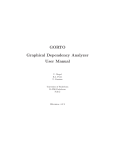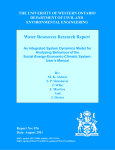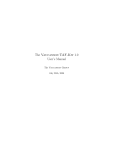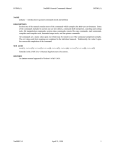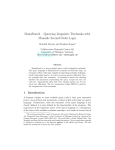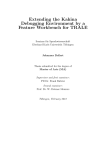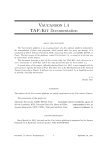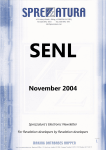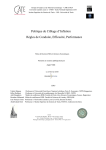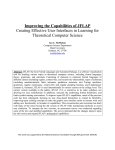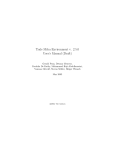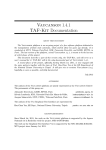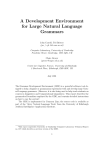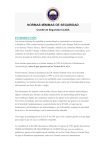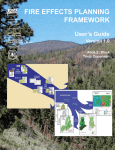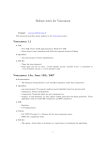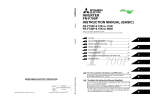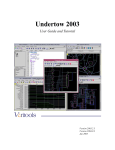Download fsm2 – A Scripting Language for Manipulating Weighted
Transcript
fsm2 – A Scripting
Language for
Manipulating Weighted
Finite-State Automata
User Manual
Thomas Hanneforth
version 1.0.0 beta
12.01.2011
fsm2 – A Scripting Language for
Manipulating Weighted Finite-State
Automata
Table of Contents
INTRODUCTION ...............................................................................................................................3
COMMAND LINE ARGUMENTS ....................................................................................................3
START-UP FILES ........................................................................................................................3
COMMAND/ FILE NAME COMPLETION ...................................................................................3
FSM2 COMMANDS ............................................................................................................................4
GENERAL .....................................................................................................................................4
STACK COMMANDS .....................................................................................................................5
SETTINGS RELATED COMMANDS ................................................................................................6
fsm2 – A Scripting Language for Manipulating Weighted Finite-State Automata | 12.01.2011
INPUT/OUTPUT ............................................................................................................................8
1
COMMANDS RELATED TO SYMBOL SPECIFICATIONS ...............................................................12
VERSION RELATED COMMANDS ...............................................................................................12
FSM ALGEBRA ...........................................................................................................................13
UNARY COMMANDS ..............................................................................................................13
BINARY COMMANDS .............................................................................................................14
OPTIMIZATION AND CONVERSION ...........................................................................................16
COMMAND RELATED TO STATISTICAL MODELLING ................................................................18
COMMANDS RELATED TO PATTERN MATCHING......................................................................19
COMMANDS RELATED TO DISTANCE COMPUTATIONS ............................................................20
TEST COMMANDS ......................................................................................................................21
SEMIRING COMMANDS ..............................................................................................................22
SEMIRINGS .............................................................................................................................23
A NOTE ON THE STRING AND UNIFICATION SEMIRINGS .....................................................24
SEMIRING TYPES ....................................................................................................................25
THE UNIFICATION (FEATURE STRUCTURE) SEMIRING .........................................................25
USING MACROS..............................................................................................................................27
COMMANDS RELATED TO MACROS ..........................................................................................27
SOME NOTES ON MACROS .........................................................................................................28
USING VARIABLES..........................................................................................................................31
COMMANDS RELATED TO VARIABLES, ENCODINGS AND SUBSTITUTIONS .........................31
LANGUAGE MODELING ................................................................................................................32
CLASS-BASED LANGUAGE MODELS ......................................................................................33
FSM<2.0> REGULAR EXPRESSION SYNTAX ..................................................................................35
REGULAR EXPRESSION PRECEDENCE TABLE ............................................................................39
FILE FORMATS ................................................................................................................................40
SYMBOL SPECIFICATIONS ..........................................................................................................41
BASIC FORMAT OF A SYMBOL SPECIFICATION ......................................................................41
SPECIAL TYPES AND SYMBOLS ..............................................................................................42
SPECIAL SUPERTYPES .............................................................................................................44
SPECIAL TERMINAL SYMBOLS ...............................................................................................44
OTHER FEATURES ..................................................................................................................46
GENERAL LEXICON FILES ..........................................................................................................47
“ACYCLIC” LEXICON FILES........................................................................................................48
GRAMMAR RULES FILES .............................................................................................................50
GRAMMAR APPROXIMATION ................................................................................................51
DICTIONARY REWRITING FILES .................................................................................................52
TEXTUAL FSM FILES ..................................................................................................................53
EXAMPLES ......................................................................................................................................54
LIMITATION AND KNOWN BUGS ...................................................................................................62
fsm2 – A Scripting Language for Manipulating Weighted Finite-State Automata | 12.01.2011
EXIT CODES ....................................................................................................................................62
2
Introduction
fsm2 is a simple XFST-style interpreter for FSM<2.0>. Like XFST1 it is based on a stack
machine, that is, most fsm2-commands manipulate finite state machines on a stack.
There are yet some differences to XFST:
1. All higher-level operations in FSM<2.0> (on regular expressions, grammars, lexicons etc.)
are based on a symbol specification. So, the first step in fsm2 in almost every case will
consist in loading a symbol specification file.
2. There are some additional commands related to language modelling, distance
computations and longest-match rewriting.
3. The non-commutative operations concatenation, composition, difference and cross
product will work in the opposite direction compared with XFST: if two FSMs A and B
are on the stack with A being topmost, composition will compute B x A. At the moment,
this behaviour seems advantageous to me, but I may be wrong and will change this.
4. All binary operations will manipulate only the two topmost FSMs on the stack, not all as
in XFST.
Command line arguments
fsm2 – A Scripting Language for Manipulating Weighted Finite-State Automata | 12.01.2011
Currently, fsm2 can be executed in interactive or script mode:
3
$ fsm2
Starts fsm2 in interactive mode
$ fsm2 SCRIPTFILE
Starts fsm2 in script mode. The script in SCRIPTFILE
is processed and the interpreter is exited afterwards.
The default file extension for script files is .fsm2.
Start-up files
If the home directory2 contains a file .fsm2.ini, the commands in that file will be executed
right after start-up.
If additionally the current working directory contains also a file .fsm2.ini, it will also be
executed after start-up.
Command/ file name completion
On Linux systems, fsm2 supports a (context-dependent) completion mechanism (based on
the GNU readline library). By typing a prefix of a command or filename and pressing the TAB
key twice, the system will either complete the input (if the prefix is unique) or offer a list of
possible continuations.
XFST is a program by XEROX.
Under Linux, the home directory is determined using the $HOME environment variable (normally
/home/username). Under the Windows platform, the concatenation of the contents of the
%HOMEDRIVE% and %HOMEPATH% variables is used.
1
2
fsm2 commands 3
General
echoln ["STRING" …]
echo ["STRING" …] > "FILE"
echo ["STRING" …] >> "FILE"
system ["STRING"]
ls ["STRING"]
cd STRING
pwd
save-history [FILENAME]
quit
exit
bye
halt
Description
Outputs a short command description
Write all "STRING" arguments to the console. If no
argument is given, output a newline. Note that echo
with a string argument does not output a newline.
If “FILE” is specified the output strings will be
written (>) or appended (>>) to “FILE”.
Same as echo, but always outputs a newline
character at the end.
Execute the operation system command given by
STRING. If STRING is omitted, a platform-dependent
shell is opened (bash on Linux and cmd on
Windows)
List directory content
Change the working directory to STRING
Print the current working directory
Prints the interactively typed commands in the
current fsm2 session.
Note that under Linux/MacOSX a hidden file
.fsm.history is automatically created in the
current directory. This file contains all typed-in
commands of all sessions in that directory.
Exit the interpreter
FILE = a valid filename, REGEX = a regular expression, STRING = an ASCII string, SYMBOL = a
defined symbol from the symbol specification, SUPERTYPE = a super type from the symbol
specification, VAR = a defined variable. Modifiers in [] are optional, | means disjunction.
3
fsm2 – A Scripting Language for Manipulating Weighted Finite-State Automata | 12.01.2011
Command
help [TOPIC]
echo ["STRING" …]
echo ["STRING" …] > "FILE"
echo ["STRING" …] >> "FILE"
4
Stack commands
print stack
Print the current content of the FSM stack
clear stack
Removes all FSMs from the stack. Clears also the
“error occurred” flag.
clear
Removes all FSMs from the stack. Clears also the
substitution and encoding mappings and the “error
occurred” flag. The macro definitions are not cleared.
fsm2 – A Scripting Language for Manipulating Weighted Finite-State Automata | 12.01.2011
See also: substitute, encode, decode
5
pop stack
Remove the topmost FSM from the stack
flip stack
Exchange the two topmost FSMs on the stack
turn stack
Reverse the whole FSM stack
Settings related commands
continue-on-error on|off
[default: off] If on, script execution continues after a
severe error.
Note that the “error occurred” flag which triggers the
abortion of the script execution, is reset by the
commands clear stack and source.
verbose on|off
[default: off] If verbose is on, every command is
written to the console prior execution
quiet on|off
[default: off] If quiet is on, the system doesn’t output
messages.
fn-completition on|off
[default: on] If on, file names will be completed with
the default file extension.
text-format xml|att
[default: xml] Change the text format used by print
fsm and load fsm. The argument xml specifies XML
as standard format, while att establishes the AT&T
format as the standard text format.
[default: off] Determines whether text input/output
with load fsm and print fsm
uses symbol names instead of numbers
(only if text-format=att )
use-categories on|off
[default: on] When on, the commands print words
and lookup will output categories in the format
feat=val. When off, feature values will be outputted as
normal symbols.
collect-weight-mode on|off
[default: off] Affects the output of print words. If
collect-weight-mode is on, weights of equal
strings/string pairs are abstractly added.
Note that this also affects the number of strings that
can be outputted, since collecting weights implies that
all strings must be hold in memory.
approx-delta [“FLOATCONST”]
[default: 0.0001] Outputs or changes the
approximation value d for numerical semirings. If the
difference of two floating point numbers is less than d,
the two numbers are treated as being equal.
Note that this option has an impact on the efficiency
of operations which rely on distance computations
(for example, best-path, minimize, rmepsilon). The
approximation value d should be set depending on
the semiring: smaller in case of the real semiring,
bigger for the log semiring.
fsm2 – A Scripting Language for Manipulating Weighted Finite-State Automata | 12.01.2011
use-symbol-names on|off
6
float-precision INT
[default: 8] The INT parameter determines the floating
point precision of the print fsm command (both
AT&T and XML formats). Note that the float precision
for dot (draw command) output is hardcoded with
value 3.
draw-font “FONTNAME”
[default: Times New Roman] Specifies the font used
for dot output. See draw command.
dot-latex-mode on|off
[default: off] If on, the draw command produces dotfiles to be processed with the dot2tex command (see
http://www.fauskes.net/code/dot2tex/)
[experimental]
lookup-unique-analyses
on|off
[default: on] lookup-unique-analyses determines
whether analyses with the same weights are counted
as several analyses.
See also: lookup-max-analyses
lookup-max-analyses N
[default: unlimited (-1)] Sets the max. number of
fsm2 – A Scripting Language for Manipulating Weighted Finite-State Automata | 12.01.2011
analyses outputted by lookup and lookup-file.
7
lookup-unique-analyses determines whether
analyses with the same weights are counted as distinct
analyses.
See also: lookup-unique-analyses
compress-binary-files on|off
[default: on] Affects the behaviour of the save fsm
command. If set to on, binary fsm2 files will be
compressed before they are saved to a file.
Note that not every binary fsm2 format supports
compression.
See also: save fsm , convert
settings
Shows the current settings.
sysinfo
Show size information about states, symbols and
weights
Input/Output
source FILE
include FILE
Read in FSM<2.0> script in "FILE".
load fsm FILE [binary]
[transducer]
Load an FSM from a file named FILE. If binary is
The default file extension for FSM<2.0> scripts is .fsm2.
omitted this file must be in XML or AT&T format as
written by the print fsm command. If binary is
specified FILE must be in one of the binary file formats
defined by FSM<2.0> (see save fsm command).
Note: if FILE is in AT&T format and represents a
transducer, the keyword transducer MUST be
specified (since the AT&T format is underspecified)
If FILE is in XML-format, the current semiring (see
section Semiring commands) must match the semiring
specified in the XML file. Also the internal symbol and
state sizes must be compatible with the ones stated in
the XML file)
load regex FILE [verbatim]
Load the regular expression in FILE. Note that only the
first line in FILE is read in.
If verbatim is specified, the special regex syntax is
deactivated and spaces are treated as regular symbols.
See section File Formats.
load grammar FILE
[approximate]
[dont-replace-preterminals]
Load a “context free” grammar in FSMCFGCompiler
format from FILE. If approximate is given, the
grammar will be compiled with the approximation
algorithm by Mohri & Nederhof.
If dont-replace-preterminals is given, preterminals
(that is, nonterminals that do not have other nonterminals in the grammar rule's right-hand side) are not
replaced.
The default file extension for grammar files is .grm.
See section File Formats.
fsm2 – A Scripting Language for Manipulating Weighted Finite-State Automata | 12.01.2011
See also: text-format, print fsm, save fsm
8
load lexicon FILE [verbatim]
Load a lexicon in FSMLexCompiler format from FILE.
The resulting FSM contains the disjunction of these
regular expressions which may use all available regular
expression operators. This file format is useful for
representing lexicons and corpora. The default file
extension for lexicon files is .lex.
If verbatim is specified, the special regex syntax is
deactivated and spaces are treated as regular symbols.
See section File Formats.
See also: load acyclic-lexicon
load acyclic-lexicon FILE
Load a lexicon in FSMLexCompiler format from FILE
and compiles in into a minimal FSM.
As opposed to the load lexicon command, the
lexicon in FILE must denote an acyclic FSM. Moreover,
no special regex operators except concatenation are
allowed (but category/feature-value syntax with
fsm2 – A Scripting Language for Manipulating Weighted Finite-State Automata | 12.01.2011
underspecification is allowed). For acceptors, the
9
compilation uses a memory-efficient and fast
incremental minimization algorithm, thus allowing
much bigger lexicons to compile.
For transducers, first the lexicon is compiled to a trie
which is afterwards minimized. The memory
requirements are thus bigger as in the unweighted case.
The input lexicon need not be sorted. Semirings with
multiple outputs are also supported.
Note: Note that big lexicons with too much
underspecification in the type system may cause the
compiler to run out of memory, since internally a
disjunctive normal form is created prior to creating the
minimized machine.
Note also that in case of lexicons denoting transducers
the result is not in every case minimal (but nearly
minimal), since final weights may in some cases be
realized earlier on the path.
See also: load lexicon
load contextrules FILE
Load a set of context rules in the FSM<2.0> context rule
compiler format from FILE.
See section File Formats.
regex "REGEX" [verbatim]
Compile the regular expression (given by REGEX) to a
FSM and push it on the stack.
If verbatim is specified, the special regex syntax is
deactivated and spaces are treated as regular symbols.
See section FSM<2.0> Regular Expression Syntax
map SYMBOL [“REGEX”]
([unary]) Assign the FSM originating from REGEX to
SYMBOL and add the pair to the substitution map (see
substitute command). This assignment remains valid
until a clear command is issued. If REGEX is not
specified, SYMBOL will be mapped to a copy of the FSM
on top of the stack.
See section FSM<2.0> Regular Expression Syntax
apply "REGEX" [bestpath]
[unary] Apply REGEX to the FST at the top of stack and
output the resulting strings on the console. If the FSM
on top of the stack is weighted and bestpath is
specified, only the best result strings are shown.
apply accepts arbitrary regular expressions whereas
lookup is restricted to plain (UTF-8) input strings. On
the other hand, lookup is much faster than apply.
lookup "STRING" ["STRING" …]
[unary] Lookup all STRINGs in the FSM on top of the
stack and output the strings STRING is mapped to.
Note that the symbols in STRING are interpreted
literally; there is no special regular expression syntax.
lookup-nbest N "STRING" …
[unary] Lookup the n-best STRINGs in the FSM on top
of the stack and output the strings STRING is mapped
to. Note that the symbols in STRING are interpreted
literally; there is no special regular expression syntax.
lookup file IFILE [> OFILE]
lookup file IFILE [>> OFILE]
[unary] Same as lookup above, but lookups up all
string in the text file named IFILE which contains one
word per line. If OFILE is specified, the results of
lookup are written or appended to OFILE. In that case, a
second file named OFILE.noanalysis is created to
which all inputs from IFILE are written/appended for
which there are no analyses.
draw FILE
[unary] Create a visual representation of the FSM on
top of stack in Graphviz (dot) format
print fsm %VAR% [> FILE]
[unary] Print FSM named by %VAR% in XML or AT&T
format to console or FILE.
See text-format command.
fsm2 – A Scripting Language for Manipulating Weighted Finite-State Automata | 12.01.2011
The difference between apply and lookup is that
10
print fsm [> FILE]
[unary] Print FSM on TOS in XML or AT&T format to
console or FILE.
See text-format command.
save fsm FILE
[unary] Save the FSM on top of stack to a binary file.
Note that currently FSMs based on the string semiring
(also as a component semiring) cannot be saved in
binary format. Instead the XML format has to be used.
See also: print fsm, load fsm
input [“PROMPT”]
Allows the user to type in a (weighted) regular
expression. If the regular expression is enclosed in
double quotes, these symbols will be stripped off.
PROMPT is an optional message prompting the user to
enter the regular expression.
fsm2 – A Scripting Language for Manipulating Weighted Finite-State Automata | 12.01.2011
print words [> FILE]
print words [>> FILE]
language
strings
fsminfo [properties]
11
[unary] Output the (finite) language of the FSM on top
of stack. If FILE is specified the output strings will be
written (>) or appended (>>) to FILE.
[unary] Output information about the FSM on top of
stack. If properties is specified Boolean properties
are shown.
Commands related to symbol specifications
load symspec FILE
[utf-8] [precompiled] [att]
Load the symbol specification (in FSMSymSpec
format) in FILE. If FILE is in UTF-8 format, add the
utf-8 keyword. The precompiled modifier causes
load symspec to assume a precompiled symbol
specification. This format is useful in case of symbol
files with several hundred thousand of symbols. If att
is specified the internal mapping form symbols to
numbers is compatible with AT&T’s lextools.
The default file extension for symbol files is .sym, the
default file extension for precompiled symbol files is
.psym.
For a description of the format of a symbol
specification see File formats.
print symspec
Outputs the current symbol specification in
Version related commands
set version “Major.Minor.Build”
Set the version number of all FSMs subsequently
written to files in XML and binary format
(commands print fsm and save fsm).
All three parts of the version number are integers.
print version
Print the version of the FSM on top of stack
fsm2 – A Scripting Language for Manipulating Weighted Finite-State Automata | 12.01.2011
precompiled format.
12
FSM Algebra 4
All unary commands manipulate (replace) the FSM on top of the FSM stack.
All binary commands manipulate (replace) the two topmost FSMs. If the operation is
commutative the first operand will be the second FSM on the stack.
Unary commands
star
closure
plus
[unary] Compute the star closure of an FSM
reverse
[unary] Reverse an FSM, that is reverse its
[unary] Compute the plus closure of an FSM
language
complement [ALPHABET]
[unary] Compute the complement of an
deterministic, unweighted acceptor.
If ALPHABET – which must be a supertype in the
symbol specification – is given, the set of
subtypes of ALPHABET will be used for
fsm2 – A Scripting Language for Manipulating Weighted Finite-State Automata | 12.01.2011
complementation. By default, the alphabet used
corresponds to the special <sigma> supertype.
complete
transitions from q to s for every state q with every
symbol for which there is no outgoing transition.
Operand must be a deterministic, unweighted
acceptor. Note: the sink state s will be a final state
project 1
project 2
substitute
[unary] Project the input/output tape of a FST
[unary] Applies the currently defined
substitutions (see map command) to the FSM on
top of stack.
ignore “SYMBOLSTRING”
[unary] Ignore all symbols in SYMBOLSTRING
bestpath
[unary] Construct an FSM which represents the
best path
optional
[unary] Construct an FSM which also accepts
encode {weights, labels}
[unary] Encodes the FSM on top of the stack.
That means that input/output labels and/or
weights are mapped to a single new symbol. This
mapping is stored in an internal data structure
and is used by decode.
decode {weights, labels}
4
13
[unary] Add a sink state s with a -loop and add
[unary] Decodes FSM on top of the stack.
FSA = Finite state acceptor, FST = Finite state transducer, FSM = FSA or FST
Binary commands
concat [N]
[binary]
Compute the concatenation of two FSMs.
Note that the operand on top of the stack will be the
second operand of the concatenation.
If a number N ( > 1) is specified, the topmost N FSMs
are concatenated.
union [N]
[binary]
Compute the union (disjunction) of the two topmost
FSMs. If a number N ( > 1) is specified, the topmost N
FSMs are unioned.
intersection
intersect
[binary]
Compute the intersection (conjunction) of two FSMs
(both must be acceptors).
Note: for best performance both operands should be
(i)label sorted.
[binary]
Compute the difference of two acceptors. The second
operand must be deterministic and unweighted.
Note that the operand on top of the stack will be the
second operand of the operation.
Note: for best performance both operands should be
label sorted.
compose [do-not-connect]
composition [do-not-connect]
[binary]
Compute the composition of two FSMs.
Note that the operand on top of the stack will be the
second operand of the composition.
For debugging purposes the option do-not-connect
may be specified to prevent the final connection step.
Note: for best performance the first operand should
be olabel sorted, and the second operand should be
ilabel sorted.
See also: compose
fsm2 – A Scripting Language for Manipulating Weighted Finite-State Automata | 12.01.2011
difference
14
compose3
[ternary]
Compute the composition of three FSMs (the FSM on
top of the stack being the last one).
Currently, all three FSTs should not contain <phi> and
<?>-transitions. Also, the outer FSMs are currently
restricted to acceptors.
The command is best suited for edit-distance
computations where the inner FST represents a
weighted edit-distance function.
Note: for best performance the first operand should
be olabel sorted, and the third operand should be
ilabel sorted.
See also: edit-distance-fst
crossproduct
product
[binary]
Create the crossproduct of two FSAs.
fsm2 – A Scripting Language for Manipulating Weighted Finite-State Automata | 12.01.2011
Note that the operand on top of the stack will be the
15
second component of the product.
Optimization and conversion
rmepsilon [incremental]
[unary] Remove ε-transitions. If incremental is
given, an alternative algorithm (not based on
distance computation) is used. This incremental
algorithm is used by default in “p-subsequential”
semirings not having the path property (like the
string and unification semiring).
determinize
[unary] Determinize FSM (in case of certain FSTs
and weighteds FSAs) this may lead to an endless
loop. Note that weighted acceptors (not
transducers) over certain “p-subsequential”
semirings (like the string and unification
semiring) admit p-subsequential determinization.
This means that a finite number of weights may
minimize
[unary] Minimize (weighted) FSA
optimize [ilabel|olabel]
[encoded]
[unary] Apply rmepsilon -> determinize ->
minimize, encoded minimization in case of FSTs.
If ilabel or olabel are specified the result of
the optimization is sorted after the given
criterion.
If encoded is specified, weighted acceptors are
also treated with encoded minimization.
synchronize
[unary] Try to synchronize an FST. May lead to
an endless loop.
epsnormalize
[unary] Try to rearrange all ε-output labels of an
FST after all non-ε-output labels. May lead to an
endless loop.
push weights
[initial|final|
residual-weights-final]
[unary] Push the weights in FSM towards the
initial or final state(s). Default is initial.
If residual-weights-final is specified, the
weight potential of the start state is multiplied
with all final states’ weights (only for
commutative semirings).
push labels [initial|final]
[unary] Push the output labels in FST towards
the initial or final state(s). Default is initial.
sort ilabel|olabel|weight
[unary] Sort the outgoing transitions of each state
after the given sorting criterion.
fsm2 – A Scripting Language for Manipulating Weighted Finite-State Automata | 12.01.2011
be associated with some final state.
16
connect [renumber]
[unary] Remove all useless states. If renumber is
specified the states of the FSM will be
renumbered afterwards to avoid gaps in the state
numbering.
compact
[unary] Reduces memory requirements by
reallocating state and transition tables.
collect-weights
[unary] Replaces all identically labelled
transitions leaving a state and heaving the same
destination state a single transition, where the
weights are semiring-added.
remove-weights
neutralize-weights
[unary] Replaces all weights by the neutral
element of multiplication (defined by the
semiring). The result will nevertheless be
weighted.
invert-weights
[unary] Replaces all transition and final states
fsm2 – A Scripting Language for Manipulating Weighted Finite-State Automata | 12.01.2011
weights by their multiplicative (left) inverses.
17
convert
list|table|matrix|compressed
[unary] Converts the representation of the FSM
on top of stack to another format. By the format
specifier the type of the external file is
determined:
list: default read-write format
table: efficient read-only format with fast access
to the transitions of a state. Better
memory footprint than list.
The matrix and compressed formats are
experimental and should not be used.
save-as-cpp classname
[unary] Converts the FSM on top of stack into
C++ code and creates pair of files classname.cpp
and classname.h. The FSM must be a deterministic
acceptor over the string semiring; classname must
be a valid C++ identifier.
Commands related to statistical modelling
Note: the commands for statistical language modelling assume that the symbol specification
defines the symbols <s>, </s> and <alpha>. The first two of these are used for delimiting the
sentences of a given corpus, while <alpha> is used for implementing back-off models.
language-model N
backoff|interpolation
good-turing|wittenbell|abs-discount|kneserney|mod-kneser-ney
ngram counter N
[simultaneous]
[unary]
Create a language model of order N (N 1).
See section Language Modeling.
Create an FST which counts N-grams and put it on the
stack. If simultaneous is given also all M-grams with
M < N are counted.
Note: For counting to be effective, the semiring must be
non-idempotent. Examples are the probabilistic (real)
and the log semiring.
Create an FST which concatenates N-grams and put it
on the stack.
Specifying backoff results in a concatenator with
failure transitions. If backoff is given the symbol
specification must define the special symbol <alpha> .
If SIGMA, a valid supertype in the symbol spec is
defined, the concatenator is based on the subtypes of
SIGMA
ngram expander N
To be documented
ngram navigator N FAILSYM
Create a special N-gram navigator WFSA for an Ngram back-off model. FAILSYM must denote the
symbol used to navigate in a superordinate or
subordinate distribution.
ngram unfolder N
To be documented
print language-weight
[unary]
Computes the language weight of the FSA on top of
stack, that is, the abstract sum of weights of strings
accepted by the FSA.
print entropy
[unary]
Print the entropy of the input FSA. Not yet.
print relative-entropy
[unary] Not yet.
fsm2 – A Scripting Language for Manipulating Weighted Finite-State Automata | 12.01.2011
ngram concatenator N
[backoff] [SIGMA]
18
Commands related to pattern matching
suffix-fsm
[unary] Create an FSA which accepts all suffixes of
strings accepted by the argument acceptor
failure-fsa FILE
Creates a Aho-Corasick-style pattern matcher from the
words in FILE.
longest-match-fst DICTFILE
[failure]
[square-brackets|
underscores]
Creates a longest-match sequential string rewriting
FSA from DICTFILE.
If failure is specified the construction of the FSA is
based on failure transitions. Otherwise, the method of
Mihov and Schulz (Efficient Dictionary-Based Text
Rewriting using Subsequential Transducers, 2005) is
used.
The FSAs resulting from the failure-method are
generally much smaller than the complete automata
created by the method of Mihov and Schulz.
DICTFILE is a two-column, tab-separated text file with
fsm2 – A Scripting Language for Manipulating Weighted Finite-State Automata | 12.01.2011
the input string in the first and the output string in the
19
second column. See section File Formats.
The last option handles the markup of the mapped
pattern: square-brackets cause the mapped patterns
to be enclosed in [ ], while underscores causes that
spaces are replaced by underscores.
Works only in the string semiring. Also supports UTF8 mode, if the symbol specification is loaded with the
utf-8 option.
Commands related to distance computations
Creates a weighted edit-distance transducer.
In idempotent semirings (tropical, Viterbi), this is a 1state transducer with a:, :a, a:a and a:b-transitions for
each symbol a,b .
a:-transitions are weighted with DELETE-COST, :atransitions with INSERT-COST, a:b-transitions with
REPLACE-COST and a:b-transitions with IDENTITYCOST, respectively.
In non-idempotent semirings (real, log), the result is a
2-state transducer representing a counting rational
power series with looping a:, :a, a:a and a:btransitions in both states (all weighted with SR::one()).
Between the two states are a:, :a and a:b-transitions
for each symbol a,b , weighted as in the idempotent
case. Note that a:a-transitions are not present.
For optimal performance, the FST created by editdistance-fst is input label-sorted and in table
format.
See also: compose3, convert
fsm2 – A Scripting Language for Manipulating Weighted Finite-State Automata | 12.01.2011
edit-distance-fst
"<DELETE-COST>"
"<INSERT-COST>"
"<REPLACE-COST>"
"<IDENTITY-COST>"
20
Test commands
test symbol „s1“ „s2“ …
Test whether s1, s2 … are symbols defined in the
symbol specification.
test acyclic
[unary] Returns true, if the FSM on top of the stack is
acyclic, otherwise false.
test epsilon-free
[unary] Returns true, if the FSM on top of the stack is
epsilon-free, that is, has no epsilon (epsilon:epsilon)
transitions, otherwise false.
test equal-length
[unary] Checks whether both tapes of the FSM on top
of the stack are of equal length (meaningful only for
transducers).
Note: only a weak version of this property is checked,
in particular, whether the FST contains :x or x:
transitions. Even if an FST contains these kinds of
transitions the underlying relation may be an equal
length relation. To be sure apply first label pushing
fsm2 – A Scripting Language for Manipulating Weighted Finite-State Automata | 12.01.2011
(see push labels) and then check for the equal-length
21
property.
test deterministic
[unary]
Checks whether the input FSM is deterministic
(acceptor) or subsequential (transducer).
Note: the function checks only for a weak version of
determinism, that is, epsilon counts as a normal
symbol. If a state has a single successor state which is
reachable by an epsilon (epsilon:x) transition then this
state would count as a deterministic one.
test functional
[unary] Not yet
test ambiguous
[unary] Not yet
test twins-property
[unary] Not yet
Semiring commands
semiring
[tropical|tsr|
probabilistic|psr|
log|lsr|
string|ssr|
maxtimes|msr|viterbi|
maxplus|arctic|
unification|fsr|
tsr_x_tsr|
tsr_x_asr|
ssr_x_tsr|
ssr_x_psr|
ssr_x_lsr|
ssr_x_msr|
fsr_x_msr|
fsr_x_tsr]
Change the currently used semiring (see next
subsection). If no argument is given, the current
semiring is shown.
Normally, the FSM stack must be empty, before
changing the semiring is allowed. In the case of some
of the numerical semirings (tropical,
probabilistic, log and viterbi), the stack may be
non-empty. In that case, the automata on the stack will
be converted automatically to the requested semiring
(transition and final state weights are translated
accordingly). This can be usefully for language
modelling purposes, where a WFSA over the
probabilistic semiring is converted to the Viterbi
semiring to compute best paths etc.
variables and substitutions defined with the define
and map command, resp.
Note that the actually available semirings depend on
compilations options in the Makefile of fsm2.
All variables, encodings and substitutions are preserved if you change the semiring and later
switch back to the original one.
fsm2 – A Scripting Language for Manipulating Weighted Finite-State Automata | 12.01.2011
Currently, the semiring command deletes all
22
Semirings
All FSM algebra operations are defined w.r.t. an abstract weight structure, a so called
semiring. The available simple semirings are5:
Name
tropical
tsr
probabilistic
psr
log
lsr
fsm2 – A Scripting Language for Manipulating Weighted Finite-State Automata | 12.01.2011
string
ssr
maxtimes
msr
viterbi
arctic
maxplus
unification
fsr
5
23
Defined
Operation applied to the
Operation applied to
on
weights along a path
multiple paths
numbers
Addition
Minimum
numbers
Multiplication
Addition
numbers
Addition
Log-Plus
-log (e-x + e-y)
strings
Concatenation
Longest common prefix
numbers
Multiplication
Maximum
numbers
Addition
Maximum
feature
Unification
Anti-unification
structures
(generalisation)
The actually available semirings depend on options specified during the compilation process.
In addition, the following complex semirings are defined:
Name
tsr_x_tsr
Meaning
Ranked product of two tropical SRs
Note that is a ranked semiring product, that is, this semiring is
idempotent and can be used in best path operations.
tsr_x_asr
ssr_x_tsr
string_x_tropical
ssr_x_psr
Ranked product of a tropical SR and an arctic SR
Product of a string SR and a tropical SR
(key-value semiring)
Product of a string SR and a probabilistic SR
(key-value semiring)
ssr_x_lsr
Product of string SR and log SR
(key-value semiring)
ssr_x_msr
Product of string SR and Viterbi SR
(key-value semiring)
fsr_x_msr
Product of unification SR and Viterbi SR
fsr_x_tsr
Product of unification SR and Tropical SR
(key-value semiring)
The default semiring is the tropical semiring.
Semirings are changed with the semiring command followed by one of the mnemonics
specified in the leftmost column in the two tables above.
A note on the string and unification semirings
Currently, not all operations are supported in the string/unification semiring (and the
semirings having the string semiring as a component). This will change in the future.
Both string and unification semirings support operations (like determinization and
minimization) on p-subsequential automata. That is, determinization of WFSMs over these
semirings may result in deterministic WFSA where the final states may be associated with a
set of final weights.
fsm2 – A Scripting Language for Manipulating Weighted Finite-State Automata | 12.01.2011
(key-value semiring)
24
Semiring types
Currently, fsm2 defines the semiring types explained in the following table:
Type
Simple semiring
(-p-subsequential)
Simple semiring
(+p-subsequential)
Ranked tuple semiring
fsm2 – A Scripting Language for Manipulating Weighted Finite-State Automata | 12.01.2011
Key-value semiring
25
Members
tropical
log
probabilistic
viterbi
arctic
unification
string
Meaning
tsr_x_tsr
tsr_x_tsr_x_tsr
tsr_x_asr
Lexicographic, idempotent tuple
ssr_x_tsr
ssr_x_lsr
ssr_x_psr
ssr_x_msr
fsr_x_msr
fsr_x_tsr
p-subsequential semirings admitting
Simple semirings.
Final weights were semiring-added
Simple semiring which admit multiple
final weights.
semirings with the path property,
suitable for best path search
multiple final state outputs. The operation applies to both key and
value semirings. When determinizing,
the values of final outputs with the same
key are additively combined. When the
keys are different, the key-values pairs
are added to the final output set.
The unification (feature structure) semiring
Basically, an (untyped) feature structure is a directed, acyclic graph where edges are labelled
with features and final states with atomic feature values.
The following table summarizes the (Prolog-style) syntax of feature structures in fsm2:
Syntax rule
FS
FSLIST
FSLIST
FEAT
VALUE
VALUE
ATOM
VAR
OPT_COREF
VAR = | ε
[ FSLIST ] | [] | $top$
FEAT : VALUE
FEAT : VALUE , FSLIST
[a-z] [A-Za-z0-9]*
OPT_COREF (ATOM | FS)
VAR
[a-z0-9] [A-Za-z0-9_]* | + | - | *
[_A-Z] [A-Za-z0-9]*
The next table lists some examples for feature structures in fsm2:
Example
[]
Comment
The empty feature structure (bottom, )
[num:pl,case:nom]
[f:X,g:X]
A feature structure where the features f and
g co-refer to the same value (which is bottom,
the most general feature structure)
[subj:X=[agr:[pers:3, num:pl]],pred:X]
A feature structure where the features subj
and pred co-refer to the same value which is
a complex feature structure
$top$
The inconsistent feature structure (signalling
Example: German lexicon with some forms of the verb werfen (to throw)
geworfen
<[vform:part2]>
wirf
<[vform:fin,mood:imp,num:sg]>
werft
<[vform:fin,mood:imp,num:pl]>
werfe
<[pers:1,num:sg,tns:pres,mood:ind,vform:fin]>
wirfst
<[pers:2,num:sg,tns:pres,mood:ind,vform:fin]>
wirft
<[pers:3,num:sg,tns:pres,mood:ind,vform:fin]>
werfen
<[pers:1,num:pl,tns:pres,mood:ind,vform:fin]>
werft
<[pers:2,num:pl,tns:pres,mood:ind,vform:fin]>
werfen
<[pers:3,num:pl,tns:pres,mood:ind,vform:fin]>
fsm2 – A Scripting Language for Manipulating Weighted Finite-State Automata | 12.01.2011
unification failure)
26
Using macros
A fsm2 macro can be understood as a subprogram with parameters. Macros can be defined
in scripts or interactively.
Commands related to macros
macro MACRONAME( PARAM1 ... PARAMN )
Starts the definition of macro MACRONAME. In
interactive mode, the interpreter prompt
changes to MACRONAME.
MACRONAME may consist out of upper and
lowercase letters, digits, underscore and
hyphen characters. Macro names are casesensitive.
endmacro
Finishes the definition of the current macro.
call MACRONAME( PARAM1 ... PARAMN )
Calls the macro specified by MACRONAME.
Each macro call is executed within its own
subinterpreter. If a macro leaves its FSM
fsm2 – A Scripting Language for Manipulating Weighted Finite-State Automata | 12.01.2011
stack non-empty, the top element of the
27
subinterpreter’s stack will be automatically
pushed on the stack of the calling interpreter.
foreach ( VAR in FILE )
call MACRONAME( PARAM1 ... PARAMN )
Reads FILE line by line and call macro
print macros
Prints all currently defined macros.
print macro MACRONAME
Prints the definition of the macro called
MACRONAME for each line.
MACRONAME.
clear macros
The basic structure of a macro is the following:
macro MACRONAME ( PARAM1 ... PARAMN )
command1
…
commandk
endmacro
Macro example
macro test(FN,RE)
load symspec %FN%
regex “%RE%”
endmacro
Clear all macro definitions.
Formal macro parameters used in the macro’s body are enclosed with %.
Macros are called with the call command:
Macro example (con’d)
call test(sigma,ab)
The foreach command can be helpful to apply a sequence of commands to every line of a
given file, for example, for testing purposes.
Example: Using foreach
macro print_words(RE)
regex "%RE%"
print words
echoln
pop
endmacro
foreach (R in "test.txt") call print_words(%R%)
fsm2 – A Scripting Language for Manipulating Weighted Finite-State Automata | 12.01.2011
# Assume that “text.txt” contains the following entries, one in each line:
# abc, ca|ab, cde
28
Some notes on macros
Macros can call other macros (but a macro cannot call itself).
A macro must have been defined before it can be called.
There are two types of macro parameters:
1. String parameters: file names, constants, regular expressions, command parameters
(but not keywords of commands or subcommands). Each occurrence of a formal
string parameter within a macro definition is replaced by the actual string parameter.
Although you can pass regex or filename parameters as such to a macro, it is
recommended that you enclose them in double quotes, especially if they contain
special symbols like brackets.
2. FSM parameters: these are given by a local or global FSM variable which must not be
enclosed in double quotes. FSM parameters are passed to the macro by value.
Variables defined with the define command inside a macro are local to this macro
FSM variables outside the scope of a macro definition are global and can be used inside a
macro.
If there are a local and a global variable with the same name, the local variable is
fsm2 – A Scripting Language for Manipulating Weighted Finite-State Automata | 12.01.2011
preferred.
29
All macros operate on different FSM stacks. If you want to transfer information to a
called macro, this can be solely done by using macro parameters or global variables
(this changed from prior versions of fsm2 where a macro had access to the calling
macro’s stack).
To use the top FSM of the caller’s FSM stack as a macro argument, fsm2 defines the
special variable %TOS% (top of stack).
When a macro call finishes, it is checked whether the stack of the called macro is nonempty. If this is the case, the topmost FSM on the called macro’s stack is pushed on the
stack of the calling macro. In that way, a macro can return FSMs to the caller.
Macro definitions cannot be nested.
Example
macro replace(ALPHA,BETA,GAMMA,DELTA)
regex “%ALPHA% -> %BETA% / %GAMMA% _ %DELTA%”
endmacro
macro replace_test(FN,ALPHA,BETA)
load symspec %FN%
# Define two local variables for the left and right context
define LC c
define RC d
# The replace macro is called with two string parameters
# (ALPHA and BETA) and two FSM parameters (LC and RC)
call replace(%ALPHA%, %BETA%, %LC%, %RC%)
endmacro
fsm2 – A Scripting Language for Manipulating Weighted Finite-State Automata | 12.01.2011
# Call replace_test. The result will be placed on the stack
call replace_test(“sigma.sym”, ”ab|cd”, ”x”)
30
Using variables
fsm2 – A Scripting Language for Manipulating Weighted Finite-State Automata | 12.01.2011
Variables can be defined with the define command:
31
Variable example
[0]> load symspec sigma
Symbol specification sigma.sym (6 user symbols, 4 supertypes, 0
categories) loaded in 0s
[0]> regex "ab"
[acceptor, 3 states, 1 final states, 2 transitions]
[1]> define var1
Variable var1 defined: [acceptor, 3 states, 1 final states, 2 transitions]
[1]> define var2 "ba"
Variable var2 defined: [acceptor, 3 states, 1 final states, 2 transitions]
[1]> print vars
var1
[acceptor, 3 states, 1 final states, 2 transitions]
var2
[acceptor, 3 states, 1 final states, 2 transitions]
[1]> regex "%var1%|%var2%"
[acceptor, 5 states, 2 final states, 4 transitions]
[2]> print words
ab
ba
Defined variables (enclosed in %) may occur everywhere in a regular expression. The %s
must be omitted after the commands push stack, define and undefine.
Commands related to variables , encodings and substitutions
define VAR ["REGEX"]
Assign the FSM denoted by REGEX to variable VAR.
If REGEX is not specified, VAR will be mapped to the
FSM on top of the stack.
undefine VAR
Undefine variable VAR.
push stack VAR
Push the FSM assigned to VAR on the stack.
print vars
Print all currently defined variables.
clear vars
Delete all currently defined variables.
clear encodings
Clears all currently defined encodings.
See also: encode, decode
clear substitutions
Clears all currently defined substitutions.
See also: map, substitute
Language Modeling
fsm2 supports the construction of different kinds of N-gram language models over different
semirings. A language model is a probability distribution over * such that the individual
string probabilities sum up to one. In terms of finite automata, a language model is a cyclic,
deterministic and robust WFSA over a real-valued semiring which assigns a (log)-probability
to every input string over some given alphabet *. Suitable choices for semirings are the
probabilistic, logarithmic, Viterbi or tropical semiring.
In principle, language models can be divided into backoff and interpolation models (for a
clarification of these notions, refer to Chen & Goodman (1998): An Empirical Study of
Smoothing Techniques for Language Modeling).
Language modeling is supported in fsm2 by the language-model command:
N is the N-gram parameter (usually 2 or 3) and backoff and interpolation define the
combination method of the different subdistributions. Backoff model use failure transitions
to continue processing in the next subdistribution in case of failure.
The last parameter determines the smoothing method (please refer to Chen & Goodman for
an explanation of these methods.
For using the language-model command, the symbol specification must define the two
supertypes SentenceBeginDelimiter and SentenceEndDelimiter, for example:
Example: Delimiter definition
SentenceBeginDelimiter
SentenceEndDelimiter
<s>
</s>
Depending on N, the corpus which forms the base for the language model must be prefixed
with N-1 instances of SentenceBeginDelimiter and suffixed with a single instance of
SentenceEndDelimiter. When applying the language-model to some input sentence, it must
be enclosed in sentence delimiters in the same way.
Example: Construction of a toy bigram model
semiring psr
regex "[<s>](babbaaabbbabbbabbabbabba|abbbabb|aaababbbabbbabaaa)[</s>]"
language-model 2 backoff witten-bell
apply "[<s>]baba[</s>]"
fsm2 – A Scripting Language for Manipulating Weighted Finite-State Automata | 12.01.2011
language-model command syntax
language-model N backoff|interpolation
good-turing|witten-bell|abs-discount|kneser-ney|mod-kneser-ney
32
Class-based language models
Class-based language models combine a lexical distribution and a class distribution.
We assume that each input word w Word is mapped to a number of classes Classes, for
example part-of-speech categories. A lexical distribution L may then represent the
conditional distribution P(w|c) for all w Word and c Classes.
The class distribution C is a language model based on Classes as alphabet.
Since typically L maps an input symbol to several classes with different probabilities (for
example in case of homography), the composition L C is a nondeterministic transducer
which may allow a number of successful paths for some input sentence. To choose a (the)
best one for some given input, we need an ordering amongst the weights assigned to each
path (see below).
The following example shows the construction of a conditional distribution from a tagged
fsm2 – A Scripting Language for Manipulating Weighted Finite-State Automata | 12.01.2011
corpus (WORD denotes the supertype for input words, POS the supertype for POS tags):
33
Example: Creation of a lexical distribution for bigram class models
semiring psr
load acyclic-lexicon tagged_corpus
define word_pos_loop "((([<sigma>])*)/d/m : [])/m"
# Create a counting series for WORD-POS-pairs and apply it to the corpus
regex "(%word_pos_loop%) (%WORD%%POS%) (%word_pos_loop%)"
compose
project 2
optimize
reverse
optimize
# Create a conditional distribution P(WORD|POS)
probabilize 2 conditional
# Create a cyclic transducer mapping words to their POS tags
regex "(%POS%:[])%WORD%"
compose
invert
regex "(%POS%)(%WORD%:[])"
compose
synchronize
closure
# Enclose the resulting FST within sentence delimiter symbols
regex "[SentenceEndDelimiter]"
concat
regex "[SentenceBeginDelimiter]"
flip
concat
optimize olabel
The input lexicon tagged_corpus.lex may look like this (each word is followed by its
corresponding POS tag):
Example: Input lexicon for the lexical distribution
[a][Det] [man][N] [sleeps][V]
[the][Det] [thief][N] [escaped][V] [the][Det] [policeman][N]
[every][Det] [boy][N] [has][V] [a][Det] [girlfriend][N]
[the][Det] [policeman][N] [owns][V] [a][Det] [book][N]
[every][Det] [man][N] [owns] [V][a] [Det] [book][N]
[he][Pron] [knew][V] [the][Det] [thief][N]
[he][Pron] [loved][V] [her][Pron]
[she][Pron] [relied][V] [on][P] [him][Pron]
she:Pron/0.25
him:Pron/0.25
he:Pron/0.25
her:Pron/0.25
the:Det/0.333
a:Det/0.333
every:Det/0.333
on:P/1
ow ns:V/0.143
relied:V/0.143
loved:V/0.143
has:V/0.143
knew :V/0.143
escaped:V/0.143
sleeps:V/0.143
book:N/0.167
girlfriend:N/0.167
boy:N/0.167
policeman:N/0.167
thief:N/0.167
man:N/0.167
0
<s>:<s>/1
1
</s>:</s>/1
2/1
The second component, the class-based language model C, is created only from the tags
taken from this lexicon (again enclosed within delimiter symbols).
The construction of language models is currently limited to the probabilistic semiring. After
construction, the resulting FSM may be converted to other numerical semirings with the
semiring command. This is necessary for parsing issues since determining the best path for
some input requires an idempotent semiring like the Viterbi or tropical semiring.
Additionally, it is useful to reinterpret the probabilities within the log-space (as negated logprobabilities) to ensure numerical stability (the tropical and log semirings share this
property). A semiring which is both stable and idempotent is the tropical semiring.
fsm2 – A Scripting Language for Manipulating Weighted Finite-State Automata | 12.01.2011
The resulting transducer looks like this:
34
FSM<2.0> Regular Expression Syntax
Note: it is advisable to enclose the regular expressions in double quotes.
Example: regex “[NOUN Case=nom]”
Literal double quotes inside regular expressions must be prefixed with \.
Basic regular expressions
a single symbol
a quoted symbol
Examples
A B C a b c ä
[Case] [$] \*
Quoting (with []) is generally necessary in case
of sequences with length > 1 or the usage of
predefined operators symbols in a literal way.
The following symbols must be quoted (either in
a category with or without features
fsm2 – A Scripting Language for Manipulating Weighted Finite-State Automata | 12.01.2011
(the order of the features is irrelevant; the
35
order of the feature values in the resulting
FSM is determined by the definition of the
category)
a numerical symbol of the form
[] or with \):
* + | ? : & - @ ! ^ ~ # \ / % $
) ( ] [ } { > < _ . =
[NOUN Case=nom Gender=fem]
[NOUN Gender=fem Case=!nom]
[NOUN Gender=masc:fem]
[NOUN Gender=masc|fem]
[NOUN Gender=masc:fem|neut:fem]
[VERB]
NOUN and VERB are defined as categories
In general, the feature-value syntax is as follows:
feat-val feature = !value
feat-val feature = value-list
value-list v1 v2 ... vk
vi value | value : value
[#99]
[#decimal] to access a symbol by its
unique symbol number
[ tropical SR ]
< > depends on the chosen semiring:
<1.0>
<’abb’>,
<’Moe\’s Bar’>
<[f:a,g:b]>
[ unification SR ]
<(’xy’,5)>
[ (string,tropical) SR ]
<(2.0,5.4)>
[ (tropical, tropical) SR ]
<(2,3,5)>
[ (trop, trop,trop) SR ]
<[f:a,g:b],0.3>
[ (unification,Viterbi) SR]
a cost in < >
The exact format of the cost within
Numerical semirings (psr, tsr, lsr,
msr, asr): an integer or float
String semiring (ssr): a string in single
quotes (single quotes within the string
must be prefixed with \)
Unification semiring (fsr): a feature
structure in [] or $top$
Tuple semirings: the tuple components
are stated in round brackets ( ) and are
separated with commas
[ string SR ]
Basic regular expressions
[<epsilon>], [<eps>],
[<e>], []
(the empty string)
[<sigma>]
(all alphabet symbols)
[<category>]
(all categories)
[<category_features>]
(all category features)
%varname%
Examples
If %varname% is a defined variable (see define
command), it is replaced by the associated FSM.
Variable names may consist out of the following
symbols: A-Z, a-z, 0-9, _, and -
fsm2 – A Scripting Language for Manipulating Weighted Finite-State Automata | 12.01.2011
Note that weight strings (enclosed in < and >) may not contain < or >, not even masked.
36
Recursive regular expressions
Prefix operators
! RE
complement of RE.
RE must denote an unweighted acceptor.
^ RE
inversion of RE (exchange of input and output labels).
RE must denote a transducer.
$ RE
contains operator (equivalent to * RE *)
Infix operators
RE1 RE2
Operatorless concatenation
RE1 | RE2
Disjunction
RE1 - RE2
Difference
RE1 : RE2
Cross product
RE1 & RE2
Intersection
RE1 @ RE2
Composition
RE1 /iff RE2
Iff-suffix-then-prefix operator. Denotes the language
fsm2 – A Scripting Language for Manipulating Weighted Finite-State Automata | 12.01.2011
where every instance of RE2 is exactly preceded by an
37
instance of RE1. RE1 and RE2 must denote unweighted
acceptors; the result will be a deterministic acceptor.
RE /i [TYPE]
Ignore in RE the terminal types in TYPE
(TYPE must be a type (super type or maximal subtype)
in brackets)
Postfix operators
RE *
star closure of RE
RE +
plus closure of RE
RE ?
optional version of RE
RE /1
first projection of RE (RE must denote a transducer)
RE /2
second projection of RE (RE must denote a transducer)
RE /r
reversal of RE
RE /b
the best path in RE (used semiring must be idempotent)
RE /pw
push weights in RE towards initial state
(RE must denote a weighted FSM)
RE /pl
push labels in RE towards initial state
(RE must denote a FST, may change its topology)
RE /e
remove epsilon transitions from RE
RE /d
determinize FSM for RE (may loop for certain FSTs)
RE /m
minimize FSM for RE
(only if RE denotes an acceptor, otherwise no effect)
Rule operators
alpha -> beta
Obligatory replacement of an instance of
alpha by an instance of beta.
alpha must denote an unweighted acceptor,
beta may be weighted.
alpha (->) beta
Optional replacement of an instance of
alpha by an instance of beta
alpha -> beta / gamma _ delta
Obligatory replacement of an instance of
alpha by an instance of beta if alpha is
preceded by an instance of gamma and
followed by an instance of delta.
alpha (->) beta / gamma _ delta
Optional replacement of an instance of
alpha by an instance of beta if alpha is
preceded by an instance of gamma and
followed by an instance of delta.
alpha -> left … right
Obligatory bracketing of alpha with left
alpha (->) left … right
Optional bracketing of alpha with left and
right
alpha @-> beta
Longest match replacement of alpha by
beta
alpha @-> left … right
Longest match bracketing of alpha with
left and right
supertype1 => supertype2
Parallel replacement: Obligatory
replacement of each direct subtype of
supertype1 with the corresponding direct
subtype of supertype2. The order is
determined by the definition of the two
super types in the symbol specification. Both
super types must have the same number of
subtypes.
supertype1 (=>) supertype2
Parallel replacement: Optional replacement
of each direct subtype of supertype1 with
the corresponding direct subtype of
supertype2. The order is determined by the
definition of the two super types in the
symbol specification. Both super types must
have the same number of subtypes.
supertype1 => supertype2 WEIGHT
supertype1 (=>) supertype2 WEIGHT
Same as above, but each symbol
replacement is associated with WEIGHT
fsm2 – A Scripting Language for Manipulating Weighted Finite-State Automata | 12.01.2011
and right
38
fsm2 – A Scripting Language for Manipulating Weighted Finite-State Automata | 12.01.2011
Regular expression precedence table
39
Operator
@
.o.
Type
Meaning
Associativity
infix
Composition
left
-->
infix
CFG operator
nonassoc
->
(->)
infix
Replacement rule
nonassoc
=>
(=>)
infix
Parallel replacement rule
nonassoc
@->
infix
Longest match rule
nonassoc
/
infix
Context introduction
nonassoc
|
infix
Union
left
&
-
infix
Intersection
left
infix
Difference
left
:
infix
Cross product
left
!
^
prefix
Complement
right
prefix
Inversion
right
/r
postfix
Reversal
left
+ *
postfix
Reflexive & transitive Closure
left
?
postfix
Optionality
left
postfix
1st, 2nd projection
left
/b
postfix
Best path
left
/i
infix
Ignore symbols
left
/pw
postfix
Push weights
left
/pl
postfix
Push labels
left
/e
postfix
Remove epsilon
left
/d
postfix
Determinization
left
/m
postfix
Minimization
left
/1
/2
Precedences go from low to high.
Lexical element
Category name
Feature names
Feature value
May consist out of any symbol, but of the following:
=
Supertype / subtype
! | : [ ] # and white space
fsm2 – A Scripting Language for Manipulating Weighted Finite-State Automata | 12.01.2011
File formats
A word on encodings
...
40
Symbol specifications
This section explains the format of symbol specification file which is the main argument of
the load symspec command.
The default file extension is .sym.
Basic format of a symbol specification
A symbol specification file consists of a collection of entries.
fsm2 – A Scripting Language for Manipulating Weighted Finite-State Automata | 12.01.2011
An entry can have two possible forms:
Supertype Subtype1 Subtype1 ... Subtypek
Category: Cat Subtype1 Subtype1 ... Subtypek
41
Example
Case
Gender
Number
Person
Person_or_Number
Category: NOUN
Category: VERB
acc dat gen nom
fem masc neut
sg pl
1 2 3
Person Number
Gender Number Case
Person Number
A subtype occurring on the right hand side of a supertype definition can be the supertype of
further subtypes. The inheritance hierarchy must form an acyclic directed graph.
The types must be ordered in such a way that all types mentioned in the right hand side of a
super type definition must be already defined (that is, the type definitions must be written in
reverse topological order of the underlying inheritance graph).
Category: is a case-sensitive keyword. Category and symbol names are also case-sensitive.
A category name (like NOUN and VERB) in the example above is also called a category marker.
The mapping from types and category names to symbols numbers is done through
a depth-first traversal of the graph. A category will be prefixed with an underscore
and will be assigned a unique symbol number. For example the category name NOUN will be
transformed to _NOUN and assigned a unique symbol number.
Only maximal subtypes (that is, types which do not have further subtypes and thus form the
leaves of the inheritance hierarchy) and category markers are assigned a symbol number to.
On the other hand, supertypes (as for example Person above) are expanded to the finite
disjunction of their (transitive) subtypes. They are thus not represented directly in an
automaton compiled from some regular expression.
Special types and symbols
Besides the symbols mentioned in the specification file there are a number of predefined
special symbols:
<epsilon>
The symbol representing the empty string (always mapped to 0).
Note that there is a second implicit -symbol labelling a self-loop
entailed by the reflexive case of the δ* transition function.
<?>
The default (also called otherwise) symbol (mapped to -3) always
consumes a symbol in the other operand. If a state q considered
while intersecting or composing two FSMs has an outgoing
transition labelled with <?>, this transition is taken for every
unmatched symbol in the other operands.
If FSM1 is “abc” and FSM2 is “a[<?>]c”, their intersection
will be “abc”.
If FSM1 is “abc” and FSM2 is “(a:x|[<?>]:y)*”, their
composition will be “abc:xyy”.
If FSM1 is “abc” and FSM2 is “(a:x|[<?>])*”, their
composition will be “abc:xbc”.
If FSM1 is “a:[<?>]” and FSM2 is “[<?>]:b”, their
composition will be “a:b”.
As can be seen from the second to last example, if an operand
contains an ID(<?>) transition, <?> acts like a variable: if <?>
matches on the upper tape a symbol a, the output tape after
composition will contain also a.
<phi>
The conditional epsilon symbol (always mapped to -2) behaves like
<epsilon>, but depends on the absence of other matching
transitions. It is also called the failure transition (and for example
used in the result of the failure-fsa command). If a state q
considered while intersecting or composing two FSMs has an
outgoing transition labelled with <phi>, this transition is taken, if
no other normal transition can be used.
Examples:
If FSM1 is “ab” and FSM2 is “[<phi>]ab”, their intersection
will be “[<epsilon>]ab” = “ab”
If FSM1 is “a” and FSM2 is “([<phi>]:x)a”, their
composition will be “a:xa”
fsm2 – A Scripting Language for Manipulating Weighted Finite-State Automata | 12.01.2011
Examples:
42
<bos>
matches the beginning of an FSM
Note that <bos> is a symbol which may only occur in the left
context of a replacement rule. It then merely controls the rule
compilation and disappears afterwards.
Example:
[Lowercase] => [Uppercase] / [<bos>] _
replaces every lowercase letter by the corresponding uppercase
letter at the beginning of an input.
<eos>
matches the end of an FSM
Note that <eos> is a symbol which may only occur in the right
context of a replacement rule. It then merely controls the rule
compilation and disappears afterwards.
Example:
[] -> [$] / _ [<eos>]
inserts a dollar sign at the end of each input string
fsm2 – A Scripting Language for Manipulating Weighted Finite-State Automata | 12.01.2011
<sigma>
43
<sigma> , being the topmost type, is expanded to all other
terminal types (but not the a before mentioned special symbols)
<category>
is expanded to all defined categories (introduced with the
Category: keyword)
<category_features>
is expanded to all terminal symbols (that is category markers like
_NOUN and feature values) of all defined categories.
As can be seen from the examples, <phi> and <?> will never be present in the result of the
composition/intersection.
Some restrictions apply to <phi> and <?>
There can be at most one <?> or <phi> transition at any state.
A <phi> transition may currently not contain a regular symbol on the input or output
side of the transition. That is, transitions like “[<phi>]:a” or “a:[<phi>]” are ruled out.
If both operands have corresponding states with outgoing <?> or <phi> transitions, both
symbols are treated as ordinary symbols.
If a state has both <?> and <phi> transitions, <?> will be given priority, regardless whether
<?> matches a transition or not.
The following hierarchy describes the semantics and interplay of <phi> and <?>:
$$ TODO
Special supertypes
In addition, the user may define special supertypes for parametrizing tasks like language
modelling or grammar compilation:
Command
language-model
Description
Defines the delimiter symbol for marking
the beginning of sentences in language
modelling tasks. The supertype
SentenceBeginDelimiter must only have a
single subtype, for example:
SentenceBeginDelimiter
SentenceEndDelimiter
language-model
Defines the delimiter symbol for marking
the beginning of sentences in language
modelling tasks. The supertype
SentenceEndDelimiter must only have a
single subtype, for example:
SentenceEndDelimiter
NONTERMINAL
LEFTBRACKET
RIGHTBRACKET
load grammar
<s>
</s>
When using the create-bracket-fst
option of load grammar, the symbol
specification must define three super types
which must have the same number of
direct subtypes. NONTERMINAL defines all
the nonterminals used in the grammar.
The ith subtype of LEFTBRACKET
(RIGHTBRACKET) defines the left (right)
bracket of the ith subtype of NONTERMINAL.
An example:
NONTERMINAL
LEFTBRACKET
RIGHTBRACKET
S NP VP
(S (NP (VP
S) NP) VP)
Special terminal symbols
$unknown$
If a symbol specification defines this special symbol (for example, as a
subtype of some user-defined supertype), all undefined terminal
types will be mapped to $unknown$. Thus, “undefined symbol”
warnings will be avoided and the processing will become more
robust.
Note that this currently affects only the commands regex and
define.
fsm2 – A Scripting Language for Manipulating Weighted Finite-State Automata | 12.01.2011
Supertype
SentenceBeginDelimiter
44
45
fsm2 – A Scripting Language for Manipulating Weighted Finite-State Automata | 12.01.2011
Other features
# (in column 1) may be used to add comments.
Moreover you can recursively include further symbol files through the use of the
#include statement:
fsm2 – A Scripting Language for Manipulating Weighted Finite-State Automata | 12.01.2011
Example
# Include a second symbol file
#include “symspec2.sym”
46
General lexicon files
General lexicon files are disjunctions of arbitrary regular expressions
Comments start with a # symbol (at any column)
fsm2 – A Scripting Language for Manipulating Weighted Finite-State Automata | 12.01.2011
Example
# Lexicon containing some English noun stems
# The symbol signature contains the following:
# Letter
a b c d e f g h I j k l m n o p q r s t u v w x y z
# Number
sg pl
# StemType normal special
# Category: NSTEM Number StemType
47
dog
fox
box
piano
table
sheep
butterfly
(goose : goose)
(goose : geese)
(mouse : mouse)
(mouse : mice)
[NSTEM
[NSTEM
[NSTEM
[NSTEM
[NSTEM
[NSTEM
[NSTEM
[NSTEM
[NSTEM
[NSTEM
[NSTEM
StemType=normal]
StemType=normal]
StemType=normal]
StemType=normal]
StemType=normal]
StemType=special]
StemType=normal]
Number=sg StemType=special]
Number=pl StemType=special]
Number=sg StemType=special]
Number=pl StemType=special]
Lexicons are loaded with the load lexicon command.
The default file extension is .lex.
Currently, there is no file inclusion mechanism.
“Acyclic” lexicon files
“Acyclic” lexicon files – they are called acyclic because the resulting FSM must be acyclic –
are disjunctions of restricted regular expressions. Currently, these regular expressions may
only use (invisible) concatenation. Lexicons may denote transducers – in that case an entry
may contain a colon (:) somewhere in the line. Round brackets for grouping are currently not
supported. Feature-value syntax is supported, but currently limited to the simplest form
feat=atomic-value (so, no negation or disjunction operators are supported). Underspecification
is supported but may lead to memory problems since the compiler expands the
underspecified entry to disjunctive normal-form. Semiring weights (in < >) may occur
everywhere in the line
Example: German indefinite determiners
ein : eine [ARTINDEF Number=sg Case=acc Gender=neut]
ein : eine [ARTINDEF Number=sg Case=nom Gender=masc]
ein : eine [ARTINDEF Number=sg Case=nom Gender=neut]
eine : eine [ARTINDEF Number=sg Case=acc Gender=fem]
eine : eine [ARTINDEF Number=sg Case=nom Gender=fem]
einem : eine [ARTINDEF Number=sg Case=dat Gender=masc]
einem : eine [ARTINDEF Number=sg Case=dat Gender=neut]
einen : eine [ARTINDEF Number=sg Case=acc Gender=masc]
einer : eine [ARTINDEF Number=sg Case=dat Gender=fem]
einer : eine [ARTINDEF Number=sg Case=gen Gender=fem]
eines : eine [ARTINDEF Number=sg Case=gen Gender=masc]
eines : eine [ARTINDEF Number=sg Case=gen Gender=neut]
Lexicons are loaded with the load acyclic-lexicon command. This command uses an
efficient incremental compiler which creates minimal FSMS. The input file needs not to be
sorted.
The default file extension is .lex.
Currently, there is no file inclusion mechanism.
fsm2 – A Scripting Language for Manipulating Weighted Finite-State Automata | 12.01.2011
Comments start with a # symbol (at any column)
48
Context rule files
Context rule files contain replacement rules of various types.
Lines may contain the special keywords optional and obligatory which control the
application mode of the rules. The default is obligatory. The scope of these keywords
reaches to the next restatement of one of them.
Rules are composed in the order in that they appear in the text file.
fsm2 – A Scripting Language for Manipulating Weighted Finite-State Automata | 12.01.2011
Comments start with a # symbol.
49
Examples
# Suppose the underlying symbol spec contains:
# Uppercase A B C D E F G H I J K L M N O P Q R S T U V W X Y Z
# Lowercase a b c d e f g h I j k l m n o p q r s t u v w x y z
# Letter Uppercase Lowercase
# Gender masc fem neut
# Case nom acc
# Number sg pl
# Category: NSTEM Gender
# Category: NINFL Number Case
# Bracket
( )
Obligatory
[Letter]+ -> [<epsilon>] / [NSTEM] _ [NINFL]
[NSTEM] -> [<epsilon>]
[_NINFL] -> [_NOUN]
# The next rules are interpreted optionally
optional
d -> z
e -> v|w
# Replace each uppercase with its corresponding lowercase letter
[Uppercase] => [Lowercase]
# Longest-match replacement
a(b*) @-> x|y
# Longest-match bracketing
a(b*) @-> [(] ... [)]
# Bracketing
a(b*) -> [(] ... [)]
Context rule files are loaded with the command load contextrules.
The default file extension is .rules.
Note that context rules are in general computationally expensive, so compiling a rule file
with many rules can take a long time.
Grammar rules files
A grammar rule file consists of quasi context-free rules. The general format is:
LHS --> REGEX
Comments start with a # symbol (not necessary in column 1).
Example: simple probabilistic CFG (semiring = probabilistic)
# Simple PCFG
# (all probabilities for a specific nonterminal sum up to 1.0)
# Lexicon
[N]
-->
[V]
-->
[V]
-->
[V]
-->
[Det] -->
[children] <1.0>
[sleep] <0.3>
[know] <0.4>
[sleeps] <0.3>
[the] <1.0>
Grammar rules may be split into several lines when using \ as the last symbol in a line
(which is not the last line):
Example: Grammar rule split into several lines
[VERB] --> [VERBPREFIX]? \
[VERBROOT] \
[VERBSUFFIX]
Grammar files are loaded with the load grammar command. The default file extension is
.grm.
A multiline rule can be commented out by adding a # at the beginning of the first line.
The right-hand side of a grammar rule may also specify a transduction.
Subgrammars may be included with the #include “FILE” statement.
There are some restrictions on the rules (of course, context-free languages can’t be
recognized by finite-state automata)6.
The technical restriction is the following: Every strongly-connected component of the grammar’s
dependency graph must be either left-linear or right-linear.
6
fsm2 – A Scripting Language for Manipulating Weighted Finite-State Automata | 12.01.2011
# Phrase structure
[S]
--> [NP] [VP] <1.0>
[NP]
--> [Det] [N] <0.7>
[NP]
--> [N] <0.3>
[VP]
--> [V] [NP] <0.5>
[VP]
--> [V] [NP] [NP] <0.35>
[VP]
--> [V] [S] <0.15>
50
Grammar approximation
Grammars not fulfilling the technical requirement stated above can nevertheless be compiled
approximately (with the approximate keyword). After approximation, the current
directory will contain a file grammar_file_name.approx which contains the approximated
fsm2 – A Scripting Language for Manipulating Weighted Finite-State Automata | 12.01.2011
grammar.
51
Dictionary rewriting files
The input file of the longest-match-fst command is a two-column, tab-separated text file
with the input string in the first and the output string in the second column.
Example: Input file of the longest-match-fst command
his
1
her
2
she
3
he
4
us
5
fsm2 – A Scripting Language for Manipulating Weighted Finite-State Automata | 12.01.2011
If the second column is empty, the output string is equal to the input string.
52
Textual FSM files
fsm2 supports two types of text files to store FSMs: the AT&T format and an XML format.
Files in one of these formats are stored and loaded with the print fsm and load fsm
commands, resp. The expected file type in these operations is controlled with the textformat command.
AT&T format
fsm2 – A Scripting Language for Manipulating Weighted Finite-State Automata | 12.01.2011
The AT&T format is a simple tab-separated format in which the lines define the transitions of
an FSM. They can be of the following forms:
53
1
2
3
4
5
Source-state
Source-state
Dest-state
Dest-state
Input-label
Label
Output-label
[Weight]
[Weight]
State
[Weight]
The first line describes the transitions of a (weighted) transducer, the second that one of a
(weighted) acceptor. Final states are represented by a state and an optional weight. In case of
multiple final weights, these lines may occur repeatedly. The source state of the first
transition in the file is used as the start state.
States are positive numbers, labels are either numbers (with 0 denoting ) or symbols,
depending on the status of the use-symbol-names switch. Weights are represented in the
genuine weight syntax (without < and >), so for example, strings are enclosed in ' etc.
Note that the AT&T format is underspecified with respect to the transducer property.
Therefore, the user has to add the transducer option to the load fsm command when
loading a transducer.
XML format
Examples
Compiling regular expressions
FSM<2.0> interactive interpreter v1.0.0 (tropical semiring)
Type 'help' for help on commands
Rule application
FSM<2.0> interactive interpreter v0.9.9 (tropical semiring)
Type 'help' for help on commands
[0]> load symspec sigma
Symbol specification sigma.sym (8 user
loaded in 0.078s
[0]> regex "xabcdx"
Regex compiled in 0s
[acceptor, 7 states, 1 final states, 6
[1]> regex "ab|bc -> x"
Regex compiled in 0.016s
[transducer, 5 states, 3 final states,
[2]> compose
Intersected/composed FSMs in 0s
[transducer, 9 states, 1 final states,
[1]> project 2
FSM projected in 0s
[acceptor, 9 states, 1 final states, 9
[1]> print words
xaxdx
xxcdx
symbols, 2 supertypes, 0 categories)
transitions]
30 transitions]
9 transitions]
transitions]
fsm2 – A Scripting Language for Manipulating Weighted Finite-State Automata | 12.01.2011
[0]> load symspec sigma
Symbol specification sigma.sym (8 user symbols, 2 supertypes, 0 categories)
loaded in 0.078s
[0]> regex "abc|da|ac|cc|dbac|ba"
Regex compiled in 0s
[acceptor, 16 states, 6 final states, 15 transitions]
[1]> print words
abc
ac
ba
cc
da
dbac
54
Compiling lexicons
FSM<2.0> interactive interpreter v1.0.0 (tropical semiring)
Type 'help' for help on commands
fsm2 – A Scripting Language for Manipulating Weighted Finite-State Automata | 12.01.2011
[0]> load symspec sigma
Symbol specification sigma.sym (119 user symbols, 12 supertypes, 0
categories) loaded in 0.016s
[0]> load lexicon eng_words
Lexicon "eng_words.lex" (79767 lines) loaded in 0.766s
[acceptor, 696281 states, 79765 final states, 696280 transitions]
[1]> determinize
FSM determinized in 0.218s
[acceptor, 199610 states, 79765 final states, 199609 transitions]
[1]> minimize
FSM minimized in 0.171s
[acceptor, 35798 states, 5894 final states, 76206 transitions]
[1]> print words > words.txt
Strings written to file words.txt.
55
Compiling lexicons
(example lexicon over the unification semiring from page 23)
FSM<2.0> interactive interpreter v1.0.0 beta (tropical semiring)
Type 'help' for help on commands
[0]> semiring unification
Semiring changed to 'unification'
[0]> load symspec sigma
Symbol specification sigma.sym (40 user symbols, 0 supertypes, 0
categories) loaded in 0s
[0]> load lexicon werfen.lex
Lexicon "werfen.lex" (11 lines) compiled in 0.016s
[weighted acceptor, 57 states, 10 final states, 56 transitions, 0 epstransitions]
[1]> optimize
FSM optimized in 0s
[weighted acceptor, 20 states, 5 final states, 21 transitions, 0 epstransitions]
[1]> draw werfen ""
Dot file "werfen.dot" created.
The resulting WFSA can be seen on the next page.
L EXICON WFSA
fsm2 – A Scripting Language for Manipulating Weighted Finite-State Automata | 12.01.2011
OVER THE UNIFICATION SEMIRING
56
Compiling lexicons
(example lexicon over the (fsr,msr) key-value semiring from page 18)
FSM<2.0> interactive interpreter v1.0.0 beta (tropical semiring)
Type 'help' for help on commands
[0]> semiring fsr_x_msr
Semiring changed to '(unification,Viterbi)'
[0]> load symspec sigma
Symbol specification sigma.sym (40 user symbols, 0 supertypes,
0 categories) loaded in 0s
[0]> load lexicon ein.lex
Lexicon "ein.lex" (13 lines) compiled in 0.016s
[weighted acceptor, 53 states, 12 final states, 52 transitions,
0 eps-transitions]
[1]> optimize
FSM optimized in 0s
[weighted acceptor, 9 states, 6 final states, 8 transitions,
0 eps-transitions]
fsm2 – A Scripting Language for Manipulating Weighted Finite-State Automata | 12.01.2011
The lexicon file ein.lex lists the indefinite articles in German:
57
Example: Lexicon with all forms of German indefinite article ein
(with some invented probalilities)
eines <([lemma:eine, cat:artindef, number:sg, case:gen, gender:neut],0.30)>
eines <([lemma:eine, cat:artindef, number:sg, case:gen, gender:masc],0.70)>
einer <([lemma:eine, cat:artindef, number:sg, case:dat, gender:fem],0.25)>
einer <([lemma:eine, cat:artindef, number:sg, case:gen, gender:fem],0.75)>
einen <([lemma:eine, cat:artindef, number:sg, case:acc, gender:masc],1)>
einem <([lemma:eine, cat:artindef, number:sg, case:dat, gender:neut],0.6)>
einem <([lemma:eine, cat:artindef, number:sg, case:dat, gender:masc],0.4)>
eine <([lemma:eine, cat:artindef, number:sg, case:acc, gender:fem],0.2)>
eine <([lemma:eine, cat:artindef, number:sg, case:nom, gender:fem],0.8)>
ein <([lemma:eine, cat:artindef, number:sg, case:acc, gender:neut],0.15)>
ein <([lemma:eine, cat:artindef, number:sg, case:nom, gender:neut],0.65)>
ein <([lemma:eine, cat:artindef, number:sg, case:nom, gender:masc],0.2)>
The following figure shows the resulting weighted automaton.
Perfect hashing
FSM<2.0> interactive interpreter v1.0.0 beta 2 (tropical semiring)
Type 'help' for help on commands
fsm2 – A Scripting Language for Manipulating Weighted Finite-State Automata | 12.01.2011
[0]> regex "dog<1>|cat<2>|fish<3>|tiger<4>|lion<5>|chicken<6>"
Regex compiled in 0s
[weighted acceptor, 27 states, 6 final states, 26 transitions]
[1]> optimize
FSM optimized in 0s
[weighted acceptor, 20 states, 1 final states, 24 transitions]
[1]> print words
dog <1>
cat <2>
fish <3>
tiger <4>
lion <5>
chicken <6>
58
fsm2 – A Scripting Language for Manipulating Weighted Finite-State Automata | 12.01.2011
Counting N-grams
FSM<2.0> interactive interpreter v0.9.9 (probabilistic semiring)
Type 'help' for help on commands
59
[0]> load symspec sigma
Symbol specification sigma.sym (118 user symbols, 11 supertypes, 0
categories) loaded in 0s
[0]> load lexicon eng_words
Lexicon "eng_words.lex" (79767 lines) loaded in 0.75s
[acceptor, 696281 states, 79765 final states, 696280 transitions]
[1]> optimize
FSM optimized in 0.5s
[acceptor, 35798 states, 5894 final states, 76206 transitions]
[1]> ngram counter 3
[weighted transducer, 4 states, 1 final states, 590 transitions]
[2]> compose
Intersected/composed FSMs in 0.188s
[weighted transducer, 141532 states, 5840 final states, 332500 transitions]
[1]> project 2
FSM projected in 0s
[weighted acceptor, 141532 states, 5840 final states, 332500 transitions]
[1]> optimize
FSM optimized in 0.75s
[weighted acceptor, 595 states, 3 final states, 7054 transitions]
[1]> lookup "ing" "ate" "tio" "ion"
ing <7259>
ate <2929>
tio <3867>
ion <4527>
[1]>
Example: Creating a failure-transition FSA
FSM<2.0> interactive interpreter v1.0.0 (tropical semiring)
Type 'help' for help on commands
[0]> load symspec sigma
Symbol specification sigma.sym (26 user symbols, 1 supertypes, 0
categories) loaded in 0.078s
fsm2 – A Scripting Language for Manipulating Weighted Finite-State Automata | 12.01.2011
# words.lex contains the entries his, her, hers, she and he
[0]> failure-fsa words.lex
[acceptor, 10 states, 5 final states, 19 transitions]
60
Efficiency tips
Although, most FSM operations are very efficient in theory and practice, dealing with large
automata requires a little thought about efficiency:
1. For creating big automata, you’ll need a lot of computer memory: 2 GB or better 4 GB.
2. The operations of composition and intersection become more efficient if the two
operands are label sorted in the right way: the first operand should be sorted by output
symbol, the second one by input label (see sort)
3. Optimize early: optimize intermediate FSMs from time to time, especially before during
complicated intersections or compositions.
4. Use table format whenever possible (see convert). When sorted in an appropriate way
(see 1.) composition and intersection work much faster on FSMs in table format.
5. For symbol specifications containing several ten or even hundred thousands of symbols
use the precompiled format (created with the print symspec command and put to use
with load symspec FILE precompiled).
6. Use compose3 instead of compose for (edit-)distance computations or other compositions
fsm2 – A Scripting Language for Manipulating Weighted Finite-State Automata | 12.01.2011
which involve three FSMs.
61
7. (Insertion) rules and right contexts: When using insertion rules of the form
[] -> β / _ RC
avoid complicated expressions in the right context: β will be inserted at every position
and the correct right context will be checked afterwards which may lead to hopeless
inefficiency. Consider matching in reverse in these cases, thereby converting right
contexts to much more efficient left contexts.
Limitation and known bugs
1. The XML-parser (used for loading FSM specifications in XML format) should have better
mechanisms to point out ill-formed input.
2. The precedence order of the operators is somewhat non-standard.
3. The console program could have more options controlling its behaviour.
4. The commands compose and intersect may loop in the presence of <phi>-loops.
Exit codes
Upon termination, fsm2 uses the following exit codes to transmit information to the
Code
Meaning
0
Normal termination
1
User break
2
Some error occurred
3
Invalid script file specified at command line
fsm2 – A Scripting Language for Manipulating Weighted Finite-State Automata | 12.01.2011
operation system:
62































































